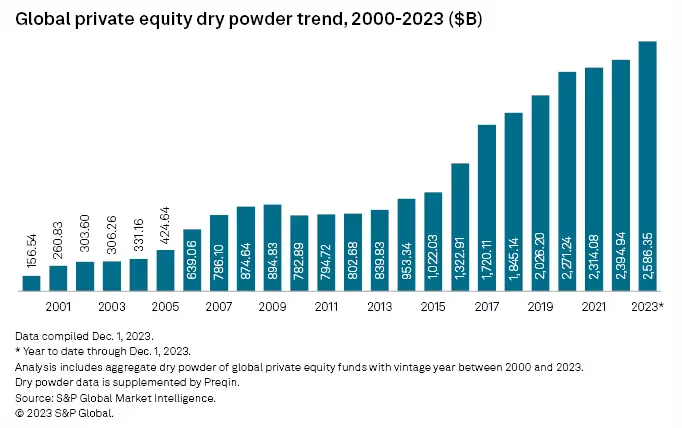It’s been a turbulent few years in private capital markets. The post-pandemic dealmaking frenzy was followed by a sharp decline in M&A activity in 2022, and by 2023, rising interest rates sank private equity (PE) activity down to its lowest point in a decade.
So, what should observers expect for the industry this year? In short, expect a rebound from recent lows.
Early indicators are promising: the Federal Reserve seems close to executing a miraculous soft landing, if it hasn’t already. The start of 2024 has been characterized by a healthy labor market and moderating inflation, giving investors hope that rate cuts are around the corner.
A resilient economy coupled with PE firms holding record levels of dry powder has money managers ready to capitalize on emerging opportunities. And they’re placing a premium on exit readiness—according to PwC, “Private capital has approximately US$12tn of assets under management (AUM), almost double what it had in 2019…highlighting the significant buildup in unrealised value. It also indicates the need for many of these investments to be exited.”
To help you get a lay of the land, we’ve curated insights from a range of experts that reveal their expectations for 2024 and how they’re optimizing their portfolios for exit readiness.
Increasing pressure to put cash to work
PE firms enter 2024 with a record amount of cash on hand, and they’re eager to deploy it productively. There’s just one problem — firms in certain sectors, especially software, are reluctant to do deals at valuations significantly below their highs in 2020 and 2021. However, higher interest rates have made those previously lofty valuations untenable for most investors, causing a stalemate and a backup of cash in the system.

As pressure builds on buyers and sellers to meet in the middle, most experts expect an uptick in dealmaking in 2024. Chris Zochowski, private equity partner at Shearman & Sterling, believes that subsiding inflation and interest rate cuts will set the stage for a modest increase in M&A activity.
These signals are encouraging, but to position themselves for attractive exits in 2024, investors and CEOs need to accept that the era of ‘expansion at all costs’ is over. What worked several years ago in a zero interest-rate policy (ZIRP) environment doesn’t work today. Instead of attracting capital via high-flying growth stories, stakeholders will have to focus on generating robust data that demonstrate the viability of their businesses in the short and long terms.
The winning formula in 2024: Good stories supported by robust data
With near-zero interest rates in the rearview mirror, investors have a renewed focus on the bottom line, even for early-stage companies.
This might mean that PE managers will have to get their hands dirty. PwC notes that “The critical need to drive value creation – both top line and bottom line – will take many PEs beyond their traditional comfort zone, forcing a more hands-on approach with a corresponding need for greater operating capacity and capability.”
Shrewd investors and operators will turn their attention to fundamental, tried-and-true value creation strategies — judicious growth plans that generate profits in the short term, balance sheet optimization, etc. Investors that bring specific expertise to the sectors they’re investing in will have a significant edge going forward, and many industry veterans believe increasing specialization among general partners (GPs) to be the new normal.
David Miller, Head of Global Private Credit & Equity at Morgan Stanley, summed it up well, saying, “In this current rate environment, value creation through operational enhancements to drive EBITDA and profitability growth will be crucial for private equity (PE) to generate alpha."
Without the tailwind of low rates, finding the sweet spot between growth and operational efficiency will be what separates high-performing funds from the rest.
Balancing growth and operational efficiency
Most private equity investors prefer to hold investments for three to seven years, which provides ample opportunity for savvy managers to unlock significant value. Growing the top line while expanding margins simultaneously is a tall order, but with the right steps, it can be done.
PE investors first need to gain a holistic understanding of their portfolio businesses, and focus on value creation opportunities that can be achieved in under seven years (and preferably less than five). EY believes that “Third-party spend, pricing and promotions, and tax savings will be prime areas of focus in 2024.” Managers that can identify the right efficiency opportunities, then execute on them, will prepare their portfolio companies for exits in 2024.
Managing liquidity in a high-rate environment is also vital. EY goes on to say that “most portfolio companies continue to have enormous opportunities to improve in many areas of working capital, especially as optimizing operational value during extended hold periods takes on increasing importance. In the recent PE pulse survey, 80% of the PE professionals surveyed indicated that they were paying more attention than usual to helping companies improve their visibility into cash and liquidity needs.”
Fortunately, tools that leverage new technologies like generative AI are allowing portfolio managers and operators to boost productivity and identify new revenue opportunities.
Embracing generative AI: The new vanguard of value creation
Portfolio company CFOs will have their hands full this year as investors expect margin expansion in tandem with growth. The good news is that emerging technologies like generative AI and advanced analytics are enabling forward-thinking companies to do more with less.
For most corporate leaders, infusing AI into their operations is a top priority these days. There’s a seemingly infinite number of applications for the technology, and a common starting point tends to be automating tedious tasks that free up employees to be more productive. Those just getting started with generative AI tend to limit their thinking to these kinds of cost saving opportunities, of which there are many. But more mature AI adopters have their sights set on loftier goals—namely, revenue-generating applications. BDO notes that “PE is likely to find that leveraging AI can help increase valuations and improve revenue. We anticipate more exploration of its potential in 2024.”
Investing in AI-powered platforms that add value—whether through greater revenue opportunities, operational efficiencies, or both—is a great option, but it’s just one piece of the puzzle. For portfolio companies aiming to increase their appeal to potential buyers, the key lies in adopting systems that seamlessly mesh with an acquirer’s existing tech stack. The ease of data migration, the ability to link platforms together, and the capacity to swiftly onboard employees onto these new tools are critical factors in this equation.
In a nutshell, PE managers looking to optimize their portfolio for exits should identify technology investments that:
- Improve operational efficiencies
- Support revenue growth
- Easily integrate with existing systems
Tropic checks all of these boxes, and can play a pivotal role in priming portfolio companies for lucrative exits.
Give your procurement process a makeover with Tropic
By sharpening cash forecasting, optimizing supplier terms, and streamlining the procurement process, portfolio companies can put themselves in an optimal position to achieve lucrative exits with Tropic.
Improve cash forecasting accuracy
Tropic provides detailed insights into a company's spend across various categories and suppliers, enabling more accurate cash forecasting. With a clearer understanding of upcoming expenses, companies can better manage their liquidity, ensuring they have the funds necessary for strategic investments. This visibility into spend analytics allows PE investors to make more informed resource allocation decisions, and helps them and company operators optimize their liquidity position ahead of an exit.
Optimize supplier terms
Winning better terms from suppliers is one of the best and most underutilized ways for firms to create value. Usually, a lack of sufficient data prevents leaders from knowing their negotiating power.
Tropic contains the largest unbiased database of SaaS suppliers on the market, allowing companies to:
- Negotiate better rates: Tropic's extensive database of supplier pricing benchmarks helps ensure you’re getting the best possible rates and terms. This can lead to substantial cost savings across the portfolio, improving exit readiness as a result.
- Consolidate suppliers: Identify opportunities to consolidate spend under fewer suppliers to achieve volume discounts and simplify the procurement process.
- Enhance payment terms: Work with suppliers to negotiate longer payment terms where possible, improving cash flow and giving companies more flexibility in managing their working capital.
Streamline procurement processes
Tropic's intelligent intake forms and automated procurement workflows streamline the procurement process, reducing the time and effort required to manage third-party spend. By minimizing manual processes and ensuring compliance with procurement policies, companies can reduce operational costs and reallocate resources to growth-driving activities.
Supporting strategic decision-making
Through Tropic's dedicated customer success and expert advisory services, PE investors and portfolio companies can receive personalized guidance on creating value through procurement and spend management. This strategic support helps identify the most impactful opportunities for cost savings and efficiency improvements, aligning with the goal of growing the top line while expanding margins.
With a range of tools that can get your operations in tip-top shape, Tropic is a no-brainer for PE investors looking to prime their portfolios for exits in 2024. Schedule a demo today and step into Procurement Paradise.
Related blogs
Discover why hundreds of companies choose Tropic to gain visibility and control of their spend.


.avif)





